Do not click the link in Mail Delivery Failure email scam
Phishing/ScamAlso Known As: Mail Delivery Failure spam
Get free scan and check if your device is infected.
Remove it nowTo use full-featured product, you have to purchase a license for Combo Cleaner. Seven days free trial available. Combo Cleaner is owned and operated by RCS LT, the parent company of PCRisk.com.
What is Mail Delivery Failure scam?
Usually, scammers use phishing emails to extract sensitive information (for example, usernames, passwords, or other login credentials, credit card details, social security numbers). It is common that they send emails containing links to phishing websites. This particular email is disguised as a letter from the mail delivery system.
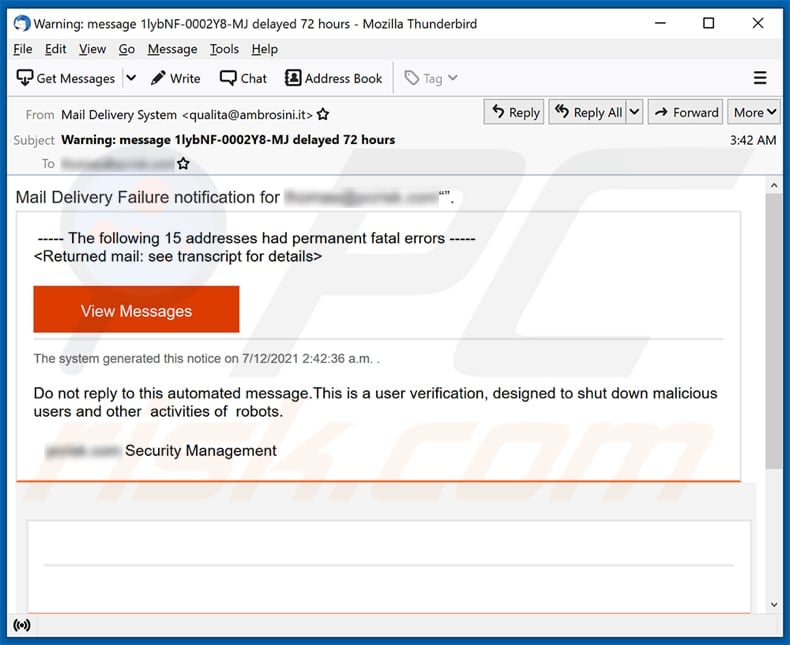
Mail Delivery Failure scam in detail
Scammers behind this email attempt to trick recipients into believing that they have received an email regarding mail delivery failure. More precisely, they try to trick recipients into viewing messages that supposedly could not be delivered due to some fatal errors in the mail delivery system.
The "View Messages" link in this phishing email opens a fake Webmail website used to trick visitors into entering their email address and a password (login credentials for Webmail email service). Two major differences between real and fake Webmail websites are their web addresses and login pages.
It is clear that scammers behind this email are trying to steal login credentials for Webmail accounts. Typically, stolen email accounts are used to deliver malware, send spam, send scams used to trick other users into making money transactions, providing personal information, or for other malicious purposes.
It is also common for stolen accounts to be checked for emails containing personal information, sold to third parties (other cybercriminals) on the dark web. Stolen login credentials could be used to access other accounts as well. Although, scammers succeed at this only when users use the same login credentials for different accounts.
| Name | Mail Delivery Failure Scam |
| Threat Type | Phishing, Scam, Social Engineering, Fraud |
| Fake Claim | Emails cannot be delivered due to fatal errors in the delivery system |
| Disguise | Letter from Webmail service provider |
| Symptoms | Unauthorized online purchases, changed online account passwords, identity theft, illegal access of the computer. |
| Distribution methods | Deceptive emails, rogue online pop-up ads, search engine poisoning techniques, misspelled domains. |
| Damage | Loss of sensitive private information, monetary loss, identity theft. |
| Malware Removal (Windows) |
To eliminate possible malware infections, scan your computer with legitimate antivirus software. Our security researchers recommend using Combo Cleaner. Download Combo CleanerTo use full-featured product, you have to purchase a license for Combo Cleaner. 7 days free trial available. Combo Cleaner is owned and operated by RCS LT, the parent company of PCRisk.com. |
Similarities with other phishing emails
Most phishing emails are disguised as letters from legitimate companies, organizations, or other entities and used to trick recipients into providing some personal information that could be used to steal identities, online accounts, make fraudulent purchases, transactions, distribute malware, or for other purposes.
More examples of phishing emails are "Anti-Spam Policy Violation Email Scam", "Novo Banco Email Scam", "RingCentral Email Scam". It is important to mention that email can be used as a channel to deliver malware. In such cases, cybercriminals use emails to trick recipients into downloading and opening malicious files.
How do spam campaigns infect computers?
Usually, emails used to distribute malware contain a malicious attachment or website link. Recipients install malware on their computers when they open a downloaded malicious file. Typically, cybercriminals attempt to trick recipients into opening malicious MS Office or PDF documents, JavaScript files, executable files like EXE, archive files like ZIP, RAR.
It is important to mention that malicious documents opened with MS Office 2010 and newer versions do not install malware automatically - they infect computers only if users enable editing/content (macros commands) in them. Malicious documents opened with older MS Office versions install malware on computers right after they get opened.
How to avoid installation of malware?
Installed programs have to be updated and activated using tools, functions provided by their official developers. It is never safe to update or activate them with third-party tools - those tools often are used to distribute malware. Also, it not legal to use cracking tools or cracked (pirated) software.
Files and website links in irrelevant emails that are received from unknown, suspicious addresses should not be opened unless there is no reason to suspect that it might not be safe. It is common for website links and attachments in emails of this kind to be used to distribute malicious software.
Programs (and files) should be downloaded from official, trustworthy websites. It is not safe to use third-party downloaders and installers, Peer-to-Peer networks, unofficial websites, and other sources, tools to download or install programs. Those tools, sources can be used to distribute malware too.
A computer should be scanned for threats regularly. It is advisable to scan it with a reputable antivirus or anti-spyware suite. If you've already opened malicious attachments, we recommend running a scan with Combo Cleaner Antivirus for Windows to automatically eliminate infiltrated malware.
Text presented in the "Mail Delivery Failure scam" email letter:
Subject: Warning: message 1lybNF-0002Y8-MJ delayed 72 hours
Mail Delivery Failure notification for “”.
----- The following 15 addresses had permanent fatal errors -----View Messages
The system generated this notice on 7/12/2021 2:42:36 a.m. .
Do not reply to this automated message.This is a user verification, designed to shut down malicious users and other activities of robots.
Security Management
Copyright© 2021
Screenshot of the fake Webmail website used to steal login credentials:
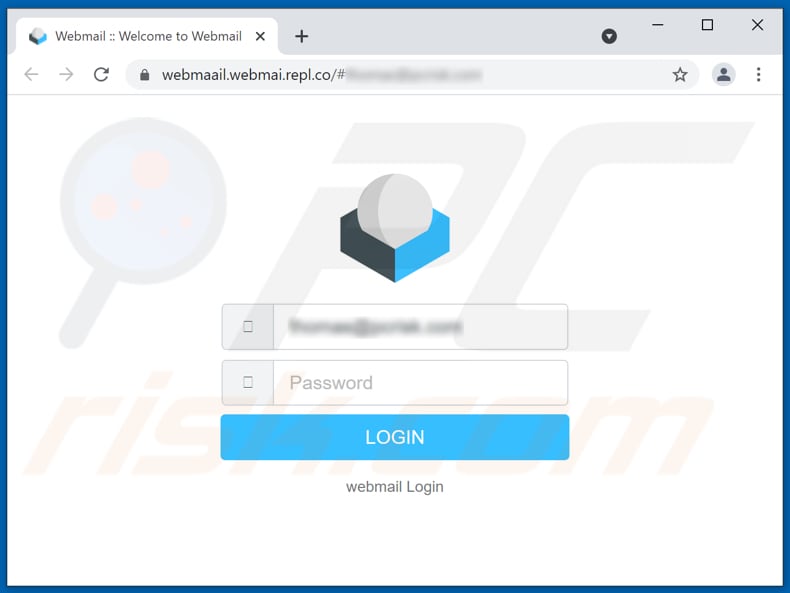
Another example of mail delivery failure-themed spam email:
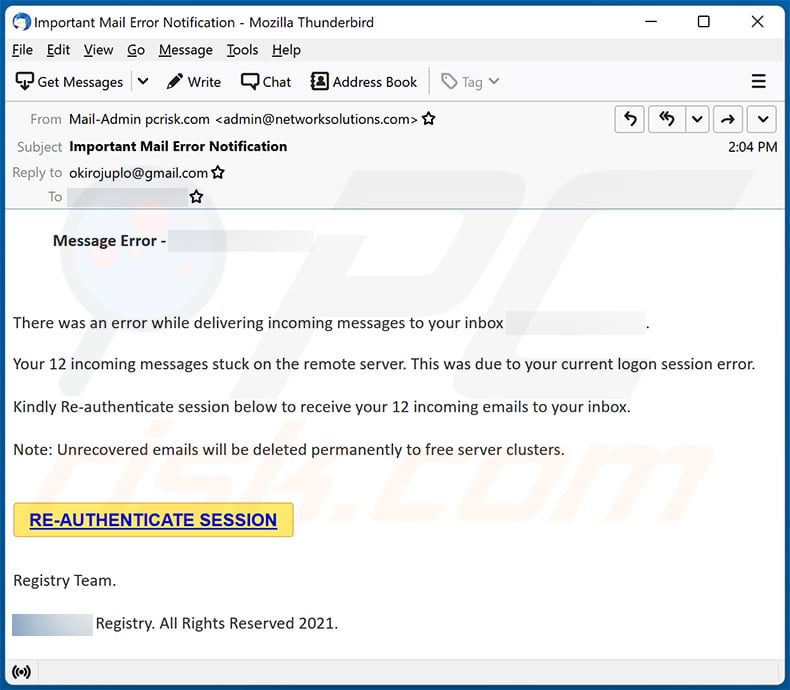
Text presented within:
Subject: Important Mail Error Notification
Message Error - ********
There was an error while delivering incoming messages to your inbox ********.
Your 12 incoming messages stuck on the remote server. This was due to your current logon session error.Kindly Re-authenticate session below to receive your 12 incoming emails to your inbox.
Note: Unrecovered emails will be deleted permanently to free server clusters.
RE-AUTHENTICATE SESSION
Registry Team.
******** Registry. All Rights Reserved 2021.
Yet another example of an email from "Mail Delivery Failure" spam campaign:
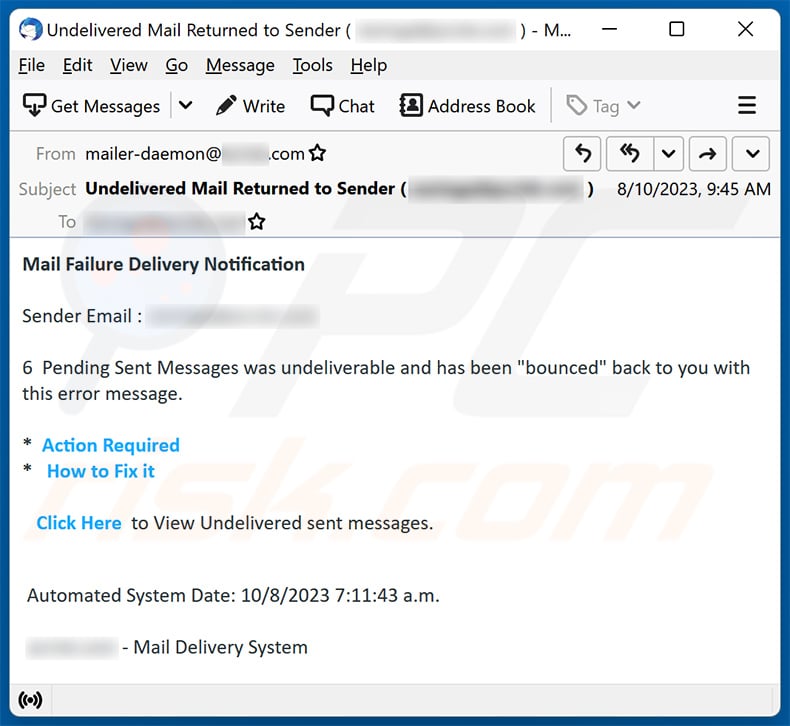
Text presented within:
Subject: Undelivered Mail Returned to Sender ( ******** )
Mail Failure Delivery Notification
Sender Email : ********
6 Pending Sent Messages was undeliverable and has been "bounced" back to you with this error message.
Action Required
How to Fix itClick Here to View Undelivered sent messages.
Automated System Date: 10/8/2023 7:11:43 a.m.
******** - Mail Delivery System
Another example of an email from "Mail Delivery Failure" spam campaign:
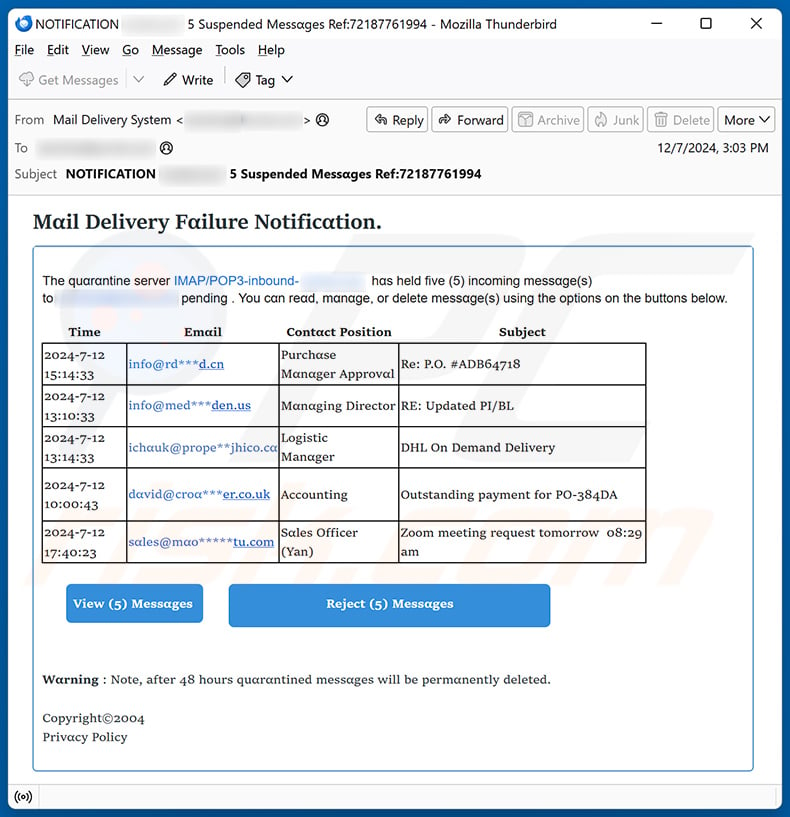
Text presented within:
Subject: NOTIFICATION ******** 5 Suspended Messages Ref:72187761994
Mail Delivery Failure Notification.
The quarantine server IMAP/POP3-inbound- ******** has held five (5) incoming message(s) to ******** pending . You can read, manage, or delete message(s) using the options on the buttons below.
Time Email Contact Position Subject
2024-7-12 15:14:33 info@rd***d.cn Purchase Manager Approval Re: P.O. #ADB64718
2024-7-12
13:10:33 info@med***den.us Managing Director RE: Updated PI/BL
2024-7-12 13:14:33 ichauk@prope**jhico.ca Logistic
Manager DHL On Demand Delivery
2024-7-12 10:00:43 david@croa***er.co.ukAccounting
Outstanding payment for PO-384DA
2024-7-12
17:40:23 sales@mao*****tu.com Sales Officer
(Yan) Zoom meeting request tomorrow 08:29 amView (5) Messages Reject (5) Messages
Warning : Note, after 48 hours quarantined messages will be permanently deleted.
Copyright©2004
Privacy Policy
Instant automatic malware removal:
Manual threat removal might be a lengthy and complicated process that requires advanced IT skills. Combo Cleaner is a professional automatic malware removal tool that is recommended to get rid of malware. Download it by clicking the button below:
DOWNLOAD Combo CleanerBy downloading any software listed on this website you agree to our Privacy Policy and Terms of Use. To use full-featured product, you have to purchase a license for Combo Cleaner. 7 days free trial available. Combo Cleaner is owned and operated by RCS LT, the parent company of PCRisk.com.
Quick menu:
- What is Mail Delivery Failure spam?
- Types of malicious emails.
- How to spot a malicious email?
- What to do if you fell for an email scam?
Types of malicious emails:
![]() Phishing Emails
Phishing Emails
Most commonly, cybercriminals use deceptive emails to trick Internet users into giving away their sensitive private information, for example, login information for various online services, email accounts, or online banking information.
Such attacks are called phishing. In a phishing attack, cybercriminals usually send an email message with some popular service logo (for example, Microsoft, DHL, Amazon, Netflix), create urgency (wrong shipping address, expired password, etc.), and place a link which they hope their potential victims will click on.
After clicking the link presented in such email message, victims are redirected to a fake website that looks identical or extremely similar to the original one. Victims are then asked to enter their password, credit card details, or some other information that gets stolen by cybercriminals.
![]() Emails with Malicious Attachments
Emails with Malicious Attachments
Another popular attack vector is email spam with malicious attachments that infect users' computers with malware. Malicious attachments usually carry trojans that are capable of stealing passwords, banking information, and other sensitive information.
In such attacks, cybercriminals' main goal is to trick their potential victims into opening an infected email attachment. To achieve this goal, email messages usually talk about recently received invoices, faxes, or voice messages.
If a potential victim falls for the lure and opens the attachment, their computers get infected, and cybercriminals can collect a lot of sensitive information.
While it's a more complicated method to steal personal information (spam filters and antivirus programs usually detect such attempts), if successful, cybercriminals can get a much wider array of data and can collect information for a long period of time.
![]() Sextortion Emails
Sextortion Emails
This is a type of phishing. In this case, users receive an email claiming that a cybercriminal could access the webcam of the potential victim and has a video recording of one's masturbation.
To get rid of the video, victims are asked to pay a ransom (usually using Bitcoin or another cryptocurrency). Nevertheless, all of these claims are false - users who receive such emails should ignore and delete them.
How to spot a malicious email?
While cyber criminals try to make their lure emails look trustworthy, here are some things that you should look for when trying to spot a phishing email:
- Check the sender's ("from") email address: Hover your mouse over the "from" address and check if it's legitimate. For example, if you received an email from Microsoft, be sure to check if the email address is @microsoft.com and not something suspicious like @m1crosoft.com, @microsfot.com, @account-security-noreply.com, etc.
- Check for generic greetings: If the greeting in the email is "Dear user", "Dear @youremail.com", "Dear valued customer", this should raise suspiciousness. Most commonly, companies call you by your name. Lack of this information could signal a phishing attempt.
- Check the links in the email: Hover your mouse over the link presented in the email, if the link that appears seems suspicious, don't click it. For example, if you received an email from Microsoft and the link in the email shows that it will go to firebasestorage.googleapis.com/v0... you shouldn't trust it. It's best not to click any links in the emails but to visit the company website that sent you the email in the first place.
- Don't blindly trust email attachments: Most commonly, legitimate companies will ask you to log in to their website and to view any documents there; if you received an email with an attachment, it's a good idea to scan it with an antivirus application. Infected email attachments are a common attack vector used by cybercriminals.
To minimise the risk of opening phishing and malicious emails we recommend using Combo Cleaner Antivirus for Windows.
Example of a spam email:

What to do if you fell for an email scam?
- If you clicked on a link in a phishing email and entered your password - be sure to change your password as soon as possible. Usually, cybercriminals collect stolen credentials and then sell them to other groups that use them for malicious purposes. If you change your password in a timely manner, there's a chance that criminals won't have enough time to do any damage.
- If you entered your credit card information - contact your bank as soon as possible and explain the situation. There's a good chance that you will need to cancel your compromised credit card and get a new one.
- If you see any signs of identity theft - you should immediately contact the Federal Trade Commission. This institution will collect information about your situation and create a personal recovery plan.
- If you opened a malicious attachment - your computer is probably infected, you should scan it with a reputable antivirus application. For this purpose, we recommend using Combo Cleaner Antivirus for Windows.
- Help other Internet users - report phishing emails to Anti-Phishing Working Group, FBI’s Internet Crime Complaint Center, National Fraud Information Center and U.S. Department of Justice.
Frequently Asked Questions (FAQ)
Why did I receive this email?
Spam emails are not personal. Cyber criminals send these letters in massive operations with the hopes that at least some of the recipients will fall for their scams.
I have provided my personal information when tricked by this spam email, what should I do?
If you have disclosed account credentials - change the passwords of all potentially compromised accounts and inform their official support without delay. And if you have exposed other private data (e.g., ID card details, credit card numbers, etc.) - immediately contact the relevant authorities.
I have read a spam email but didn't open the attachment, is my computer infected?
No, merely reading an email will not initiate any system infection chains. Since malware download/installation chains are triggered when the attachments/links found in spam mail are opened/clicked.
I have downloaded and opened a file attached to a spam email, is my computer infected?
Whether an infection chain was initiated might depend on the opened file's format. If it was an executable (.exe, .run, etc.) - most likely, yes - your device was infected. And if it was a document (.pdf, .xls, .doc, etc.), you might have avoided triggering such processes. These formats may require additional interactions (e.g., enabling macro commands) to start downloading/installing malware.
Will Combo Cleaner remove malware infections present in email attachments?
Yes, Combo Cleaner is designed to detect and eliminate threats. It is capable of removing practically all known malware infections. Note that since malicious software usually hides deep within systems - therefore, performing a complete system scan is essential.
Share:

Tomas Meskauskas
Expert security researcher, professional malware analyst
I am passionate about computer security and technology. I have an experience of over 10 years working in various companies related to computer technical issue solving and Internet security. I have been working as an author and editor for pcrisk.com since 2010. Follow me on Twitter and LinkedIn to stay informed about the latest online security threats.
PCrisk security portal is brought by a company RCS LT.
Joined forces of security researchers help educate computer users about the latest online security threats. More information about the company RCS LT.
Our malware removal guides are free. However, if you want to support us you can send us a donation.
DonatePCrisk security portal is brought by a company RCS LT.
Joined forces of security researchers help educate computer users about the latest online security threats. More information about the company RCS LT.
Our malware removal guides are free. However, if you want to support us you can send us a donation.
Donate
▼ Show Discussion